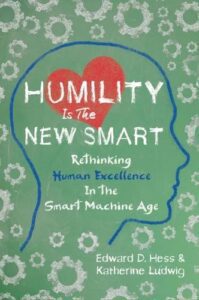 If you think being a great leader (and employee, in general) means silencing your emotions, think again. The most successful people, say Ed Hess and Katherine Ludwig, authors of Humility Is the New Smart: Rethinking Human Excellence in the Smart Machine Age are those who can leverage their emotions in a way that allows them to think better and become more creative, innovative and collaborative.
If you think being a great leader (and employee, in general) means silencing your emotions, think again. The most successful people, say Ed Hess and Katherine Ludwig, authors of Humility Is the New Smart: Rethinking Human Excellence in the Smart Machine Age are those who can leverage their emotions in a way that allows them to think better and become more creative, innovative and collaborative.
The challenge is managing your emotions in a way so that they are perceived as a strength and not a weakness. The authors offer this advice to master your emotions:
Increase positivity
Leading research by cognitive, social and positive psychologists, including Barbara Fredrickson and Alice Isen, shows that positive emotions enable and enhance cognitive processing, innovation and creativity and even lead to better judgment and decision making. By contrast, research has shown that negative emotions like fear and anxiety have the opposite effect. Negative emotions manifest in many forms, for example fear of looking bad, making mistakes, losing your job or not being liked.
The strategy is two-pronged: One, generate plenty of positive emotions, and, two, stop allowing negative emotions to control your behavior and thinking. (More on the second prong in a moment.) You can change the ratio of good and bad feelings in your head by a shift in focus. You can take more time to notice the good things in your life, both professionally and personally. You can think more often about the people you love, the times you felt good about your performance at work, and the times you felt appreciated by others. You can be thankful for what you have, instead of angry about what you don’t have.
“To stay positive, I keep a list on my desk with five daily reminders,” says Hess. “They are: One, be positive. Two, take time to exercise and meditate. Three, just smile. Four, slow down at every opportunity. Five, avoid ‘drainers,’ by which I mean negative people. By focusing on those five things, I have been able to make a significant difference in increasing my own positivity.”
Actively manage negative emotions
Examples of negative emotions are anger, fear, anxiety, dread and cruelty, and they can weigh on you if you let them. Usually, emotions last only 90 seconds unless you let them overtake you. That is key. Let negative emotions float through your mind, but don’t engage them. Additionally, don’t allow an emotion affect your behavior. Hess says: “I was never taught that I had choices about my emotions. I had to learn that emotions don’t necessarily have to lead to behaviors. It is not automatic—we make the choice about whether that happens.”
“One way to recognize when negative emotions are taking hold is to be very sensitive to physical changes that often accompany them,” says Ludwig. “For example, your heart rate may increase. You may feel warmer. You may feel tightness in your stomach. You may notice your fists are clenched. Then you should try to identify and label the emotion you are feeling. You can learn to calm yourself by taking deep breaths and engaging your thinking to get to the root of the emotions and reflect on something more positive in your life.”
Embrace the power of Otherness
Otherness is the ability to rise above our self-absorbed, ego-driven emotional defensiveness in order to connect to and emotionally relate with others. That’s crucial because we all need others in order to flourish, say Hess and Ludwig. We can’t reach our potential by ourselves. We need other people who can help us see past our cognitive biases and open our minds to new perspectives in order to think more critically and creatively.
“Otherness” requires building positive, caring regard and trust with others. When you trust someone, you feel safe to conduct the kinds of conversations that enable collaboration, problem-solving and breakthrough thinking and learning.
To build positive, caring trust requires you to take the time to connect and relate with others. That means offering them your undivided attention in the moment by facing them, making eye contact, smiling and not multi-tasking. Plus, really listen to them with an open, non-judgmental mind that is fully focused on trying to understand what they are saying.
Hess calls that type of listening “reflective listening.” Good listeners do not interrupt people. Good listeners do not formulate their answers while the other person is talking. Good listeners do not immediately respond with their views but rather first ask questions to make sure they understand what was said. Really listening to another person says, “I care about you and what you think and feel.”
Ed Hess, Professor of Business Administration and Batten Executive-in-Residence at the Darden Graduate School of Business, and Katherine Ludwig are the authors of the new book Humility Is the New Smart: Rethinking Human Excellence in the Smart Machine Age, which puts forth a new model called NewSmart, designed to help humans thrive alongside technology in the Smart Machine Age.

0 comments